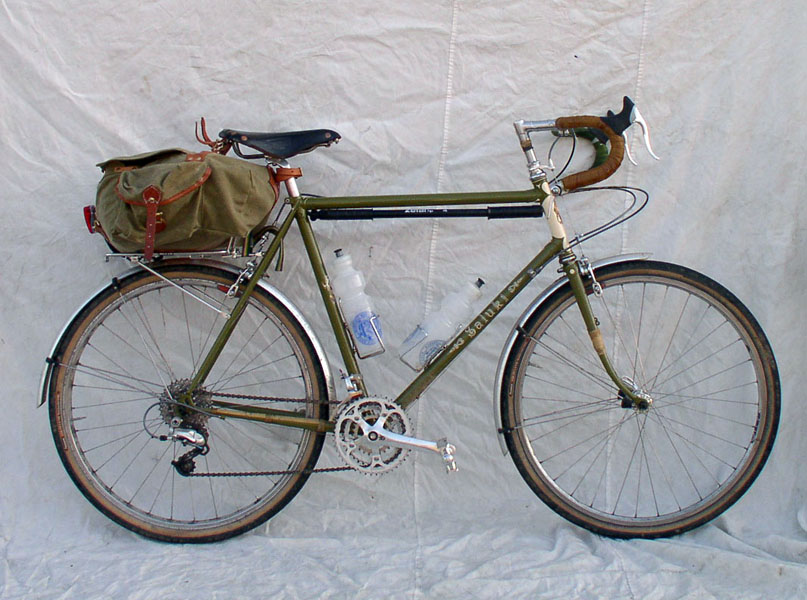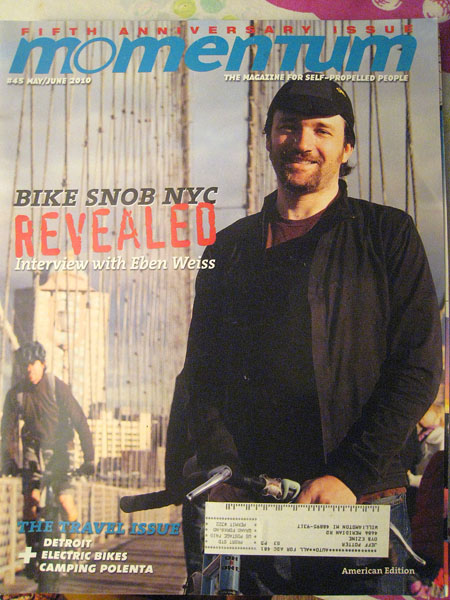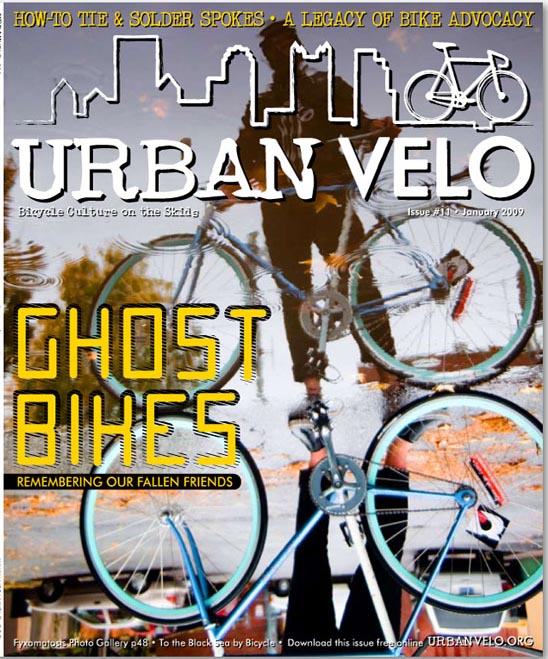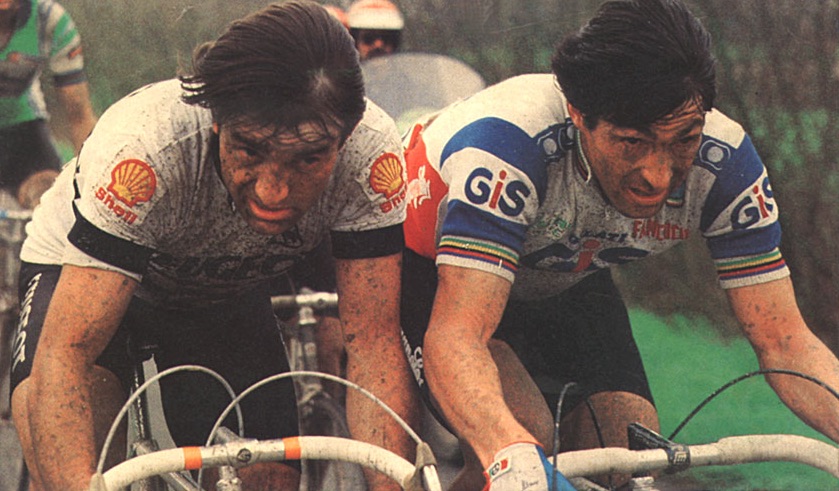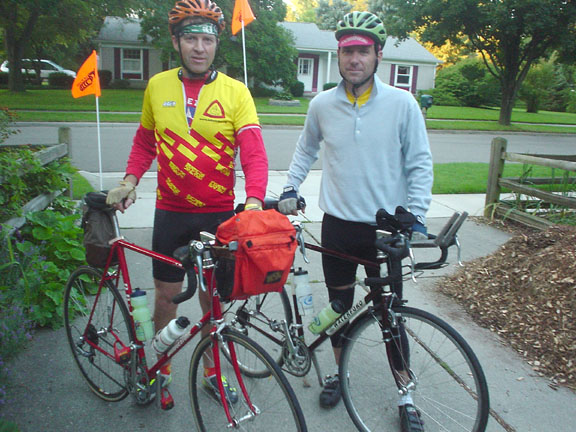—So sez Grant Petersen of Rivendell Bicycle Works in the latest “Rivendell Reader.”
By “country bike” he means a bike that’s good for rural riding just like a mt-bike is great in the steep, rocky mountains and a city bike is good downtown and a race bike is good in a race. So far, bikes designed for uses other than those 3 have been largely neglected—leaving a big mission for the Country Bike to fill.
Probably 75% of recreational riders are using a racer-style bike that simply doesn’t meet their needs.
And I suspect that country-bike-style riding amounts to about 90% of riding.
A country bike rolls fast, is light, but can do most everything else as well. It’s comfy. It can easily sport fenders, lights and racks. Thin or chubby tires. (But really the right chubby tire rolls so easily that one shouldn’t even need narrow tires for fast riding: use a bike designed for your needs and you’ll find you can ride plenty fast—and do lots of other kinds of riding, too.)
The bike in the photo is Grant’s own Saluki, created for his Rivendell Bicycle Works—check out more info at Rivendell. It qualifies, no problem, as a Country Bike.
Once more: racer-wannabe, extreme mountain and short-hop urban bikes are all great but they leave a big gap for most of today’s riding.
Country bikes are also what are called Randonneur bikes—they’re often used on long-distance amateur rides called randonnees, in French. Such bikes are great for America’s popular Century rides, too. But much rando riding starts where 100-mile Centuries leave off—with the queen of rando’s being the Paris-Bresh-Paris 750-mile nonstop ride. Rando’s also tend to include a variety of riding conditions in their routes, since rando bikes can easily handle it all, while Centuries typically go for the smoothest, newest pavement. I predict that the rando spirit is going to catch on in both bike design and event routes—and open eyes for riders. There’s a lot of great riding out there!
Let’s just consider the suspension question in further, breezy detail: how much riding really needs mechanical suspension? We all agree that comfort is great and shock-absorption is cool—but did ya know that you don’t need heavy, tricky, ugly, pricey moving parts to get the job done? Have you ever ridden a bike designed to ride the bumps softy without any add-on parts? Doubtful. It’s a Country Bike. It relies on the frame, seat, bars, stem and tires to absorb the bumps from the get-go.
Note that chubby tires can be built light and built to ride very nice and fast indeed. And they’re great for absorbing bumps. As the bike biz plunges to irrelevant race-emphasis, however, comfy road tires are becoming scarcer. This trend is ready for an about-face. Half-inch tires with 140psi aren’t going to make many riders happy for very long—especially when they find that a light, lively plump tire rolls almost as fast…and 10X as comfy.
To get into a bit more detail, the Constructeur bikes of bygone France are what started this Country Bike thang. They inspired new-era revivals of same, like the Saluki. The Japanese have also been making Country Bikes in the French mode for awhile now, especially on an elite level (see other links at this site). A couple top French makers are still out there. And there are a growing handful of Euro and Ami builders carrying the torch. The torch, I predict, is ready to spark into a brighter flame right about now.
(Jan Heine’s new book “The Golden Age of Handbuilt Bicycles” is going to be part of sparking the revival in versatile bikes, I predict. It’s the world’s most beautiful bicycle book. Beauty and function often go together! I’ll be offering it here starting in August.)
Once again: mt-bikes don’t really meet most people’s needs. They aren’t good for most riding. Plain’n’simple. They’re stiff—and so need suspension to soften their harsh ride. Their knobby tires are good for 10% of riding. But they again become too harsh when you put slicks on them. So, why’d they become so popular anyway? They look aggro; you can bash em around; they’re more comfy than race-style roadbikes. Not bad. Lotsa fun in gnarly terrain. But, really, there’s a lot more riding to be had out there.
A CB is more comfy, more versatile and faster than a mt-bike for the very common rural types of riding. However, a CB is not meant for wheelies, gnarly shredding or curb-bashing. I suppose a CB is a rider’s bike, an adult bike, a mature bike. It really opens up the riding side, for diversity and range. Yet CB’s can still look stylin’ and are a shoe-in for classy. We’ll probably see some monocoque CB’s in carbon and wild colors pretty soon, too.
Once again, race-inspired bikes are great for the 5% of riders who actually pull up to a start line, mt-bikes shine in the gnarly stuff that 10% prefer, citybikes rule for another 10% who ride short hops downtown.
That leaves a LOT of recreational riders who need different bikes than what have been pushed on them the hardest.
A lightweight, full-featured bike with plump tires just might be the ticket here.
